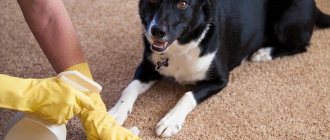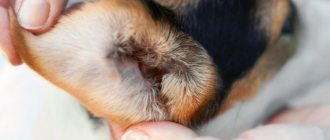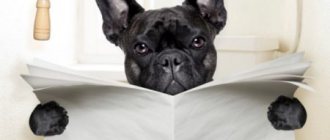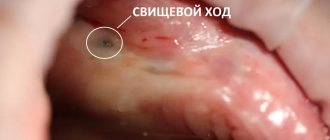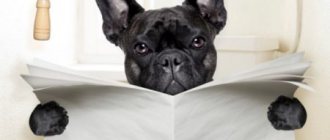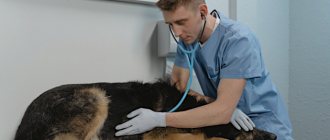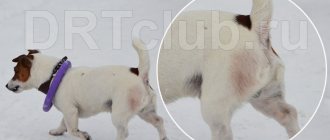Agree, it is not very pleasant to wake up in the morning from the affectionate licking of a pet, feeling that your beloved dog’s mouth stinks of rot. Such a greeting procedure may well turn into torture. However, this phenomenon is not uncommon; many owners are even sure that this is quite normal, explaining the “amber” by the fact that their four-legged pet “just ate something.” However, more experienced owners know that a strong odor can be a symptom of a dangerous disease, so they sound the alarm and ask the veterinarian questions: why does the dog’s breath smell, what to do in such a case?
Unpleasant odor in puppies
In puppies, foul odor often occurs during the teething period. If teeth fall out at the wrong time or an incorrect bite is formed, interdental gaps may form. As a result, food debris will get stuck between the teeth, which is an environment favorable for the growth of bacteria. This fact cannot be ignored, since a foul odor will constantly come from the mouth.
Another reason is late loss of baby teeth. They fit tightly in the socket, but become loose, causing food and infection to get into the gum. The inflammatory process causes suppuration. As a result, an unpleasant odor occurs.
Suppuration is also possible due to trauma in the oral cavity, since puppies have a habit of gnawing everything that gets in their way, which is why they often injure their gums.
Halitosis: what is it?
Halitosis is a veterinary term for a putrid odor from a dog's mouth. The fetid “amber” from the mouths of our little brothers in 8 out of 10 cases does not mean a cosmetic problem associated with poor oral hygiene, but a serious pathology:
- dental diseases,
- disruption of body systems,
- diseases of internal organs, for example, kidneys, liver.
Most often, halitosis is caused by bacterial decay in the mouth area. If the dog is not sick with anything, then the microflora functions normally, restraining the process of reproduction of harmful microflora. And, conversely, if one of the body’s systems fails, the microflora cannot cope with its responsibilities, which leads to the occurrence of such an unpleasant symptom - bad breath. To eliminate it, it is necessary to identify the cause that has become a provoking factor. Prescribing adequate therapy is preceded by diagnosis, taking into account the age of the animal.
The most common causes of odor:
- Dental problems . Plaque is one of the most common causes of bad breath. The stone itself does not pose a threat to health, but it can cause the destruction of enamel, the development of stomatitis, periodontitis, gingivitis, and the occurrence of foci of infection in the mouth. All these problems are accompanied by bad breath.
- Injuries to the oral mucosa and gums . If an infection gets into the wound, an infectious process and suppuration occurs, which is accompanied by a foul odor.
- Diseases of the digestive system . The stench can accompany diseases of the stomach, intestines and liver. With serious pathological processes in the liver, a strong stench of rotten meat usually occurs.
- Diseases of the genitourinary system . It often occurs in older dogs (over 10 years old), and their mouth smells like urine.
- Helminthiasis . Once in the intestines, worms densely populate it, which is why food is poorly digested and rots. This process is accompanied by a foul odor.
- Oncological diseases in the oral cavity . They often develop in dogs with a short muzzle (bulldogs, boxers, etc.) and are accompanied by a sweetish, rotten odor.
- Endocrine pathologies . Diabetes usually causes an unpleasant odor from acetone.
Treatment and how to remove the smell
Therapy prescribed to a four-legged friend aims to eliminate the root cause of the disease, because an unpleasant odor is a symptom, and not an independent disease.
An unbalanced diet is a very common cause of bad breath.
Treatment may include:
- taking antihistamines or anthelmintics;
- ultrasonic cleaning that removes stones;
- normalization of the diet and removal of prohibited foods;
- restoration of the microflora of the oral cavity.
Dry feeding protects against the formation of tartar.
Dense pieces of food clean the teeth while eating, preventing it from accumulating on the enamel.
Treatment
If the cause of the odor is poor hygiene or poor nutrition, eliminating the problem is quite easy. It is necessary to adjust the animal’s diet, eliminate fatty and sweet foods, and introduce solid foods - apples, carrots. They clean teeth well of plaque. You can add chopped tomato or tomato juice to your food to soften the plaque, and then simply remove it with a regular cotton pad. Tartar can also be removed in the clinic by contacting a veterinary dentist.
In all other cases, to identify the cause of halitosis, it is necessary to examine the dog. Only by treating the underlying disease can you eliminate bad breath.
Branches of the Bio-Vet veterinary clinic are located in all districts of Moscow, as well as in Reutov and Lyubertsy. We employ qualified specialists from all veterinary fields; the doctor will examine the dog and prescribe the correct treatment. Your pet's problem will be solved as quickly and efficiently as possible.
What to do if your dog has bad breath
Bad breath is often a sign of a serious illness, so this symptom should not be ignored. To find out the cause, you need to contact a veterinary clinic so that an experienced doctor examines your pet and prescribes the correct treatment.
It is not always easy to independently determine the reason why your dog’s breath smells. If going to the doctor is not possible, then do the following:
1. Watch your pet carefully. Assess the general condition: is the dog eating normally, is it active enough, are there any other signs of illness. If you find any deviation in the behavior of an animal, then the root of the evil lies in the condition of the internal organs. It is necessary to consult a veterinarian as soon as possible.
2. Examine the dog's mouth. If during observation you notice food stuck between your teeth or yellow plaque, then you can deal with the problem yourself by performing hygienic cleaning with a special paste and brush. If inflammation or tartar is observed in the oral cavity, then you need to contact a veterinary clinic.
Remember that unqualified help in this situation can only do harm. The sooner you take action, the faster you can get rid of the problem without serious consequences.
External factors that provoke a nasty odor
There are other mediators that cause dog mouth stink. Fortunately, they are easy to correct.
What applies to external provocateurs:
- Eating protein treats. When deli meats are metabolized, a nitrogenous product is released, which causes a rotten smell. This phenomenon can be avoided if you reduce the amount of meat and other foods rich in protein in your diet.
- Food settling in the buccal space. Pieces of food stuck behind the cheeks can fester over time and create a rotten smell.
- Change of drink. If you stop giving your pet spring water and switch to chlorinated water, this can cause dysbiosis in the animal. The disease gives rise to the spread of an unpleasant odor.
- Unbalanced pet diet. To keep your pet's breath fresh, you need to switch to natural nutrition and higher quality food.
The above problems are not so serious and can be easily eliminated.
How to get rid of bad smell
Veterinarians strongly recommend not to self-medicate if your dog’s mouth stinks. However, at home, the pet owner can still try to get rid of the bad odor coming from the dog’s mouth.
Oral hygiene
It’s quite easy to eliminate bad breath if the problem is insufficient oral hygiene: you just need to brush the animal’s teeth with a special paste. A good way to remove plaque is also to use dental treats. It is important to understand that it is possible to remove a bad odor using hygiene procedures only if it is caused precisely by the accumulation of plaque on the teeth and gums. In case of the formation of stone deposits, periodontitis and other dental diseases, assistance to the dog should be provided exclusively by a specialist.
Changing teeth
Bad mouth odor that accompanies a puppy's teeth change usually does not require any treatment and goes away on its own over time. However, this does not mean that your pet does not need to be examined by a veterinarian. The owners of a young dog need to make sure that the stench is caused precisely by the natural processes of the animal’s development, and not by pathological abnormalities in the functioning of the body. In addition, it is necessary to monitor how the teeth change. To somewhat freshen a puppy’s foul-smelling breath, experts usually advise wiping the mucous membrane of the animal’s mouth from time to time with a soda solution, which can be made from 1 glass of warm boiled water and 1 tbsp. spoon of soda.
Other cases
If, after hygiene procedures, the dog’s mouth still smells something unpleasant, this means that the pet needs to undergo a serious examination in a clinic. It may include ultrasound, blood tests, urine tests and other procedures necessary to determine the exact cause. Based on the results of the studies, the veterinarian will make a diagnosis and prescribe the appropriate medication for the dog.
Bad breath from a pet is by no means normal. If your pet's breath becomes stale, the owner should definitely contact a specialist and find out why this is happening. It is important to remember: the sooner the cause of a bad odor from a dog’s mouth is discovered, the higher the chances of maintaining the health of your four-legged friend.
Diseases that cause haliotosis in dogs
Bad odor from a dog's mouth can be caused by the following factors:
- Presence of dental diseases. Foul odors may indicate the presence of caries, which destroys teeth, or tartar, in which colonies of pathogenic bacteria develop. They appear with glossitis, stomatitis, and gum disease. This phenomenon is often observed in puppies during the period of tooth replacement. The milk molars that have not yet fallen out are destroyed, which causes an unpleasant odor. This pathology is often observed in dogs in old age, when, for natural reasons, the condition of the teeth and gums deteriorates significantly.
- Inflammatory diseases of the nasopharynx. An unpleasant odor accompanies infectious processes occurring in the throat and maxillary sinuses. It appears with tonsillitis, laryngitis, and sinusitis.
- Diabetes. With this disease, an intense odor of acetone is observed. It may also indicate an imbalance of carbohydrates.
- Diseases of the gastrointestinal tract, biliary tract, liver. Bad odor can be caused by various diseases: intestinal dysbiosis, colitis, gastritis, cirrhosis, gallbladder dyskinesia, liver necrosis.
- Malignant tumors in the digestive organs, pharynx, and oral cavity. With cancer, a rotten, sweetish smell appears.
- Anomalies in the genitourinary system. Your dog's mouth may smell like urine. This is a consequence of pathologies in the genitourinary organs: urolithiasis, pyelonephritis, etc.
Any of these signs is a signal to visit a veterinary clinic and undergo a full examination.
Wool and leather
Two elements can accumulate on wool, which together create an unpleasant odor:
- It's true that dogs sweat mostly through their paws, but that doesn't mean their coat stays dry. A small amount of sweat is released through the hair follicles of the coat. Although it is very light, over time - without proper care and bathing - it will start to smell bad.
- Natural body oils are found in the skin and are produced to help maintain healthy skin and coat. It also has a very slight odor, but as with sweat, it can build up to an unpleasant odor.
Skin conditions such as dry, irritated skin (sometimes due to allergies) can cause the body to produce more oil than usual, and so without a few extra baths with a quality product that both moisturizes and protects, oil can begin to build up. smell.
How to solve this problem:
- If your Yorkie has any kind of skin irritation (dry skin, yeast, mites), it should be treated.
- Unless your Yorkie has skin problems, the best way to control oil buildup and sweating is to bathe your puppy or dog every 3-4 weeks. It may be tempting to suggest this more often - every 2 weeks or even once a week, but too many baths - even with the right quality products - can dry out the skin, which can lead to other problems.
- Speaking of the right products, never use human shampoo. Dog shampoos are made for dogs, and choosing the right shampoo and conditioner is an important step in proper grooming. If your current shampoos are not working properly, look for quality shampoos that are best for the Yorkshire Terrier breed.
© shutterstock
How to properly care for your oral cavity
Cleaning molars begins with purchasing the necessary supplies from a pet store: special toothpaste and a soft brush. The procedure is carried out according to the following scheme:
- Place a small amount of paste on the brush.
- When cleaning, special attention is paid to the upper jaw - plaque is most often deposited on it.
- The final stage is cleaning the tongue.
The manipulation is carried out twice a week, it helps to remove repulsive odors from the dog’s mouth.
Important! Do not use baking soda or human paste. They contain components that can be harmful to your pet's health.
Plaque and tartar in small breed dogs
Hello, dear owners of dwarf and small dogs!
Today we will talk about this group of our favorites. And why they need to communicate with dentists more often than others.
Why, you ask, don’t the rest of us need dentists? Of course, dogs of medium and large breeds can also suffer from dental problems, but this happens much less frequently, and the consequences are not as fatal as for “kids”. And the reasons for going to the dentist are often completely different.
Small breed dogs (Chihuahuas, Yorkshire Terriers, Pomeranians, Toy Torriers and others) are usually distinguished by the rather early formation of tartar. Their mouths begin to smell bad, and the animal itself refuses to take hard food.
What happens in a dog’s mouth is equally unpleasant for both the dog’s owner and his four-legged pet. And this is not the end of the problem. Sometimes, due to the minimal load on the jaws, combined with the hormonal characteristics of mini-dogs, doctors observe lysis (resorption) of the bone tissue of the lower jaw. A dog with such problems will never be able to normally eat hard food.
And it all starts with dental plaque not removed in time.
What is plaque
Dental plaque is specific deposits of saliva, bacteria, food debris and tissue detritus that adhere tightly to the tooth crown or gingival margin.
There is plaque on healthy teeth too, but the thickness of such deposits can range from minimal (microbial biofilm of several microns) to very significant, visible to the naked eye. Plaque is partially washed away by saliva and erased by dense foods during feeding. If the food is soft, its components can attach to plaque, increasing the amount of plaque on your pet's teeth.
As a rule, in dogs, plaque deposits are most abundant on the outer surfaces of the canines and lateral teeth (premolars and molars), which are poorly washed by saliva. The amount of plaque increases significantly with diseases in the oral cavity.
Heavy plaque deposits and gum inflammation often cause your pet's bad breath, which gets worse with heavy and frequent breathing. Imagine that a small well-groomed Yorkshire terrier or a cute miniature Spitz can emit an odor reminiscent of the smell of a public garbage container, and a Chihuahua, wanting to lick its owner, exhales a “bouquet” worthy of comparison with the smell of rotting meat.
Halitosis (halitosis) is an unpleasant odor from the pet's mouth.
It is from the mouth, and not from the stomach, as many owners think, that the dog smells bad in the absence of oral hygiene. Please note that the smell from the stomach begins to be heard only during belching or in severe surgical diseases of the stomach in dogs.
The bad smell comes not from the stomach, but from the dog’s mouth. Look for the cause together with your dentist!
Sometimes the wearer may develop a local allergic reaction to the components of dental plaque, which subsequently turns into an inflammatory reaction. In this case, an animal whose teeth are not brushed suffers from inflammation of the gums (this is called gingivitis), surrounding tissues (periodontitis), and in especially severe cases, inflammation of the entire oral cavity (stomatitis).
Plaque causes inflammation of the gums (gingivitis and periodontitis)
Tartar and its consequences
Over time, plaque thickens and becomes saturated with mineral salts contained in saliva. This is how tartar is formed.
Tartar is a dense acquired formation at the site of dental plaque, resulting from its mineralization. As a rule, it is a mixture of phosphate and calcium carbonate with a minor content of organic matter and various microorganisms.
There is supragingival tartar, visible from the outside, and subgingival tartar, which can only be identified by a doctor through a thorough examination of your pet’s teeth and gums.
Supragingival (supragingival) tartar forms directly on the free surface of the tooth, borders the edge of the gum and puts pressure on it. Typically, the stone has a yellow or brown color, a rough surface that promotes the deposition of new layers and thereby increases the size of the stone. The mucous membrane of the lips and cheeks, located above the stone, is often injured and inflamed. Gradually, the gums around the stone atrophy, exposing the neck and roots of the tooth and opening the gates of infection.
Supragingival calculus can lead to tooth loss
Sometimes supragingival tartar can become so abundant that its “muff” covers the tooth on all sides. Often such a tooth is held in place only by this “stone coupling.” When a doctor removes tartar, the mobility of the tooth in the gum increases sharply, and the tooth simply falls out. Particularly impressionable owners blame the doctor for the fact that their pet was left without teeth as a result of removing tartar. In fact, such teeth have long been a source of suffering for their pet.
Subgingival (subgingival) tartar is formed in those places where the gums, for various reasons (inflammation, trauma), have moved away from the surface of the tooth and a gum pocket has formed. Deposits of such tartar adhere tightly to the surface of the neck or root of the tooth. These deposits are often a reservoir and conductor for surgical infection pathogens, which cause inflammation of surrounding tissues and are even carried throughout the body through the bloodstream. Subgingival tartar is less noticeable, but it is the most dangerous.
How to avoid the negative consequences of plaque and tartar in your pet
In order to avoid the appearance of plaque and stones, follow a few simple recommendations:
- Choose the right diet for your dog. This can be everyday dry food or a special food for preventing dental plaque in dogs. If the dog eats “natural” soft food, then it is necessary to provide additional stress on the teeth. To do this, you can use various treats to clean your teeth.
- Use treats and toys to clean your teeth. Treats are sold in pet stores and most often take the form of ribbed sticks or bones. Rope toys in the form of “ropes” also help clean teeth. Never use natural chicken tubular bones to prevent plaque and tartar - this is dangerous for the health and life of your pet!
Tubular chicken bones are dangerous for your pet's health!
- Brush your dog's teeth regularly. To do this, it is enough to have a bandage or gauze napkin and a special toothpaste for dogs on hand. Use a napkin wrapped around your finger with a small amount of toothpaste to brush your teeth, especially the area around the gums, once a week. If you behave carefully but persistently, your pet will quickly get used to the procedure. Those who are more comfortable can also use a special toothbrush for animals.
- If stones still begin to form, then without delay, contact your veterinarian for professional removal of plaque and stones using a special device (ultrasonic scaler) under general anesthesia.
Dentistry for dogs and anesthesia
Why does the dentist usually insist on examining your pet under anesthesia, or more precisely, under general anesthesia? It’s okay if the dog is impressionable, aggressive and disobedient. What if you’re calm? Why “narcotize” him?
The fact is that patients with an absolutely healthy oral cavity rarely see a veterinary dentist. Any more or less manifested clinical sign - be it halitosis, refusal of solid food, red gums or something else - is a reason for the doctor to conduct a thorough examination and comprehensive treatment of your pet’s oral cavity. How can you get a probe under the gum of a tooth located in the depths of a dog’s mouth, if even with a person it is sometimes difficult to agree on this?
The dog has instincts, and the dentist is a source of danger and pain. If there is no way to escape, the dog will certainly sooner or later begin to resist the doctor’s violence. But the doctor has instruments in his hands, and he must work deep in the open mouth of the animal. Therefore, the dog’s fight with the dentist poses a danger not only to the doctor’s hands, but, above all, to the patient himself. After all, the result of such a struggle can be teeth chipped on metal instruments, a fracture or dislocation of a jaw closed at the wrong time, or other injuries to the oral cavity and cheeks.
A dentist without anesthesia is a source of fear and pain for a patient
Therefore, since we want help from the doctor, it is necessary to create the best conditions for him to work with the patient, and for the patient himself - the opportunity to remain whole and not receive additional experiences and injuries.
How dangerous is anesthesia itself during dental care? Modern general anesthesia has come very far from the anesthesia of the last century. Doctors use a complex of drugs to induce relaxation and pain relief for the patient with fairly low risks to his health. The dentist's patients under anesthesia can be old animals, heart patients, and many other patients who were previously considered a “risk group.” It is only important to choose a truly competent medical team and regularly check the health of your pet.
Can some dental procedures be performed without anesthesia? In principle, no one can ban it yet. But, as a rule, such manipulations can only be of a partial examination, partial assistance, partial prevention, since full manipulations in the oral cavity are impossible without anesthesia. And the result will most likely be partial. Sometimes this is justified, but most often it is not, and is even harmful for your pet. Therefore, listen to the specialist and together with him choose the amount of dental care.
General anesthesia allows for a high-quality and complete examination and treatment of your pet’s oral cavity. The work of a doctor without anesthesia is a huge risk for the pet itself and is guaranteed to provide incomplete dental care.
I am of the opinion that small preventive measures can be carried out without anesthesia, but therapeutic measures can only be carried out under anesthesia!
Removing tartar using an ultrasonic scaler is a therapeutic procedure. It must be performed under general anesthesia!
By the way, using an ultrasonic scaler to remove tartar is a therapeutic procedure. It is unpleasant, painful, and requires a calm patient and careful work by the doctor. And the ultrasound itself is extremely unpleasant for the patient - the dog hears it! Therefore, ultrasound removal of tartar should only be done when using anesthesia.
Let's summarize the dental results
If you are the owner of a small dog, then you need to monitor the condition of its oral cavity from the moment you get your little friend.
- The main dental risks for dwarf dogs are the deposition of plaque and tartar with the development of periodontitis, lysis of jaw tissue (especially the lower jaw), tooth loss with impaired eating.
- Timely preventive measures, such as cleaning dental plaque, correct selection of food density and treats, regular monitoring by a doctor, will allow your dog to avoid meeting with the dentist for therapeutic purposes for longer.
- The appearance of tartar, bad breath or inflammatory processes in the dog’s mouth is an urgent reason to visit a veterinary dentist.
- The dentist performs examinations and treatment of the oral cavity in dogs under general anesthesia. Otherwise, quality treatment is simply impossible.
We hope you found this article helpful. If so, comment, make links and reposts, come to our groups on social networks!
A mature dog smells bad
Why does one house smell like cats, but not another?
Adult four-legged animals suffer from the problem in the presence of the following sources:
- Diseases of the nasopharynx - occur with severe hypothermia.
- Dental pathologies – with gingivitis, stomatitis, glossitis, caries and tartar.
- Diabetes mellitus - the smell of acetone is mixed with the main aroma.
- Carbohydrate imbalance is formed due to an incorrectly selected diet, with an excess of carbohydrates.
- Gastrointestinal diseases - in addition to the repulsive aroma, symptoms are accompanied by flatulence, diarrhea, and change in the color of stool.
- Malignant tumors in the mouth - may be a sign of cancer of the gums or tongue.
- Lesions of the biliary tract and liver - present in hepatitis, cirrhosis, necrosis or dyskinesia.
- Disorders of the genitourinary tract - glomerulonephritis is accompanied by shortness of breath and wheezing.
Important! The most harmless reason is the lack of regular brushing of the entire dentition.
How to eliminate bad odor from mouth
If an animal is sick, it needs to be treated - this is obvious. If the veterinarian sees no reason to worry, only care will help solve the problem:
- Taking your dog to a doctor or make-up artist to remove tartar is strictly forbidden.
- Regularly brush your pet's teeth using preventative toothpastes for dogs.
- Adding tomato juice or fresh tomatoes to the porridge is a popular recipe, but it is proven.
Professional teeth cleaning, in most modern clinics, is carried out using ultrasound. If the tooth enamel under the growths is severely damaged, the surface is filled or covered with a special gel, which will eliminate sensitivity while its base layer is restored. After brushing your teeth, which is often done under anesthesia, your dog’s mouth may smell unpleasant for 1–2 days, but after that the smell should go away. If the desired effect is not achieved, you should contact another veterinarian, since the dog clearly has health problems.
